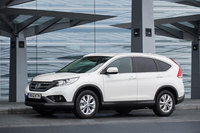New Honda CR-V receives 5-star Euro NCAP overall safety rating

The new British built Honda CR-V has been rated one of Europe‘s safest cars, according to new independent crash testing results from Euro NCAP, receiving the maximum 5-star rating.
The rating scheme focuses on the vehicle’s overall safety performance which gives consumers an easy to understand single score. The system considers occupant protection, child protection, pedestrian protection and the availability of driver aids. Since the introduction of Euro NCAP‘s current rating scheme (February 2009) all Honda models tested have achieved 5 stars - Accord, Insight, Jazz, CR-Z, Civic and most recently the new CR-V.
The new CR-V’s top safety rating reflects Honda’s commitment to overall vehicle safety. Honda’s commitment to safety is embodied by the term ‘Safety for Everyone; safety for drivers, but also safety for passengers, pedestrians and occupants of all vehicles. Honda’s car-to-car crash test facility at the Tochigi R&D plant analyses impacts between models of different sizes and weights and develops solutions to mitigate injuries for both passengers and pedestrians.
The new CR-V, produced at Honda’s state of the art manufacturing facility in Swindon, is the next model in the Honda line-up to receive the new Earth Dreams Technology 1.6 i-DTEC diesel engine. The CR-V 1.6 i-DTEC is available in two-wheel drive with manual transmission and will feature 300Nm of torque and 120 PS with CO2 emissions of only 119g/km to provide an exceptional balance of performance and economy. This new derivative will go on sale in autumn 2013.
For further information on the CR-V range visit honda.co.uk/crv.
Safety Highlights in the Honda CR-V
Vehicle Stability Assist (VSA) with Traction Control
VSA is designed to assist the driver in maintaining control during cornering, acceleration and sudden manoeuvres by applying braking to the right- or left-hand wheels as necessary and modulating the engine torque output as required.
Motion Adaptive Electric Power Steering (MA-EPS)
The system detects instability in slippery conditions both during cornering and under braking and automatically initiates steering inputs aimed at prompting the driver to steer in the correct direction. In addition to improving efficiency and optimising driver feedback, the system helps to stabilise braking and mitigate understeer and oversteer.
Emergency Stop System (ESS)
ESS automatically activates the brake and hazard warning lights (indicators) when it detects an emergency stop situation. The lights blink rapidly to warn following vehicles that the car is stopping abruptly, reducing the risk of a collision.
Advanced Driving Assist Systems (ADAS)
This is a suite of three ground-breaking technologies that raise safety to a new level:
Lane Keeping Assist System (LKAS)
LKAS uses a camera to detect the car deviating from a traffic lane and provides steering torque when necessary, thereby enhancing safety.
Adaptive Cruise Control (ACC)
ACC allows you to choose both your speed and distance from the vehicle ahead. If this falls below the set level, the system instantly decelerates the vehicle. Where quicker deceleration is required ACC will alert the driver to apply the brakes.
Collision Mitigation Braking System (CMBS)
CMBS monitors the following distance and closing rate between your vehicle and the car directly in front of it, warning the driver when a collision is likely and helping reduce impact speed when a collision becomes unavoidable.
All ADAS systems are designed to complement the driver, not to replace their input.
Advanced Compatibility Engineering (ACE) Body Structure
(ACE) Body Structure provides significantly enhanced occupant protection in a variety of real-world crash conditions. A front-mounted polygonal main frame is designed to prevent cabin deformation by distributing forces through multiple major load bearing pathways - and away from the passenger compartment. Additionally, ACE Body Structure helps to minimise the potential for under- or over-ride situations, this is particularly important where a frontal collision occurs between vehicles of differing heights, weights or frame construction.
Pedestrian Protection
The construction of the front of the new CR-V is designed to help absorb energy in the event of a collision with a pedestrian. Specific pedestrian injury mitigation features include:
An unobstructed area beneath the bonnet that allows greater space for deformation.
Windscreen wiper pivots designed to break away on impact
Energy absorbing front wing mounts and bonnet hinges
Whiplash Mitigation System
The front seats of the new CR-V incorporate a whiplash mitigation system, which is designed to help mitigate the severity of neck injuries in the event of a rear impact.

